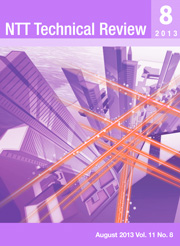
You need Adobe Reader 7.0 or later in order to read PDF files on this site.
If Adobe Reader is not installed on your computer, click the button below and go to the download site.

|
August 2013 Vol. 11 No. 8 |
|

View from the Top
-
 Srini Koushik, Chief Executive Officer, NTT Innovation Institute, Inc. Srini Koushik, Chief Executive Officer, NTT Innovation Institute, Inc.

Overview
NTT I3 (pronounced "NTT I Cube") is an innovative enterprise with global aspirations that seeks to leverage its Silicon Valley location and core strengths in original cloud and security technologies. We asked newly appointed CEO Srini Koushik to tell us more about NTT I3's core strengths, and as someone who has had a long career in the IT industry, to talk about NTT Group's current standing in the world and NTT I3's outlook for the future.
Feature Articles: Front-line Research on Graphene
-
 Graphene Research at NTT Graphene Research at NTT

Abstract
Graphene, a two-dimensional sheet of carbon atoms, was experimentally discovered in 2004. Since then, graphene research has progressed exponentially from basic science to applications. NTT aims to make a large impact on the information society through the materials science of graphene and is therefore promoting a wide range of graphene research projects from theory to devices. In this Feature Article, the current status of graphene research underway at NTT laboratories is presented.
-
 Basic Principles of Raman Spectroscopy for Graphene Basic Principles of Raman Spectroscopy for Graphene

Abstract
Graphene is a planar honeycomb network composed of carbon atoms. Even though graphene has a very simple structure, it has received considerable attention from researchers in various fields. This article explains the basic principles of Raman spectroscopy for use with graphene in order to provide insight into the unique properties of graphene.
-
 A Novel and Simple Method of Growing Atomically Thin Hexagonal Boron Nitride A Novel and Simple Method of Growing Atomically Thin Hexagonal Boron Nitride

Abstract
Hexagonal boron nitride (h-BN), a structural analogue of graphene, is an insulating material with a large band gap. The combination of graphene and h-BN is expected to lead to a wide variety of applications. Thus, the demand for large-area and high-quality growth of h-BN is increasing. This article describes a novel and very simple method for growing a large-area and atomically thin h-BN film. In this method, an amorphous solid source is converted to crystalline h-BN through diffusion of boron and nitrogen atoms in metal foil followed by precipitation at the surface.
-
 Exploring Relativistic Physics and Band Gap Detection in Epitaxial Graphene Exploring Relativistic Physics and Band Gap Detection in Epitaxial Graphene

Abstract
Graphene is a relatively new type of material whose charge carriers exhibit unique relativistic quantum behavior. Recent progress in graphene research has revealed that high-quality and large-scale epitaxial graphene can be obtained through thermal decomposition of SiC. This article describes electrical transport measurements of carrier-density-tunable epitaxial graphene devices that shed new light on graphene. For epitaxial monolayer graphene, we first report on the unusual quantum Hall effect derived from the relativistic nature of the charge carriers and further elucidate its associated physical features. For epitaxial bilayer graphene, we present a signature of a band-gap opening that can be induced by the field effect.
-
 Plasmon Transport in Graphene Plasmon Transport in Graphene

Abstract
This article describes time-resolved measurements of plasmon transport in graphene. It is demonstrated that the plasmon velocity can be varied over two orders of magnitude by changing the magnetic field, carrier density, and the gate screening effect.
-
 Surface-enhanced Raman Scattering of Graphene on SiC Surface-enhanced Raman Scattering of Graphene on SiC

Abstract
Raman scattering spectroscopy is a well-known optical tool for identifying the properties of graphene such as the number of layers, carrier concentration, and strain. Interaction between incident light and a metallic nanoparticle such as gold or silver enhances the intensity of light, which can be used in Raman scattering spectroscopy. This article describes our investigation of graphene properties by using surface-enhanced Raman scattering.
-
 Biosensing on a Graphene Oxide Surface Biosensing on a Graphene Oxide Surface

Abstract
This article describes our recent research on a selective protein detection system built on a graphene oxide (GO) surface. Our original idea is to fix pieces of GO on a solid support. This enables direct observation of chemical reactions occurring on the GO surface and on-chip device fabrication. The basic principle can be applied to other proteins as well as other biological molecules simply by changing the molecules to be modified, which makes GO a versatile platform for integrated biosensing devices.
Regular Articles
Global Standardization Activities
-
 The ITU Workshop on eHealth and the Fourth Meeting of ITU-T FG-DR&NRR in Tokyo The ITU Workshop on eHealth and the Fourth Meeting of ITU-T FG-DR&NRR in Tokyo

Abstract
The International Telecommunication Union (ITU) workshop on eHealth and the fourth meeting of the ITU-T (ITU-Telecommunication Standardization Sector) Focus Group on Disaster Relief Systems, Network Resilience and Recovery (FG-DR&NRR) were held in Shinjuku, Tokyo, February 4¡Ý8, 2013. These ITU events were held together in order to promote mutual understanding between working areas in healthcare and disaster response, and to increase NTT's presence in both fields. This article describes the main results of these events.
Practical Field Information about Telecommunication Technologies
-
 Failure Cases in Access Facilities (Aerial Metallic Communication Facilities) and Countermeasures Failure Cases in Access Facilities (Aerial Metallic Communication Facilities) and Countermeasures

Abstract
In this article, we introduce failure cases in access facilities (aerial metallic communication facilities) and countermeasures to them. This is the eighteenth in a bimonthly series on the theme of practical field information on telecommunication technologies. This month's contribution is from the Access Engineering Group, Technical Assistance and Support Center, Maintenance and Service Operations Department, Network Business Headquarters, NTT EAST.
External Awards
|
